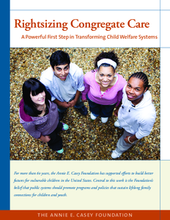This new report outlines the Annie E Casey Foundation's initiatives in four sites to help child welfare systems reduce institutional placements, improve outcomes, and support community services by changing the array of services, frontline practice, finances, performance management, and policy.
As part of this agenda, the Foundation has focused more recently on helping public systems reduce their use of institutional placements (called “congregate care”) for children and youth in child welfare systems. In the last decade, a strategy consulting group within the Foundation has tackled the issue with a diverse set of child welfare systems from around the country. The outcomes, in one jurisdiction after another, were extraordinary: Reducing a system’s reliance on congregate care had significant benefits for children and families.
“It was striking,” says Kathleen Feely, Casey’s vice president for Innovation. “Reducing reliance on congregate care resulted in marked improvements for children. They spent more time in family settings and less time in institutional settings. Reducing congregate care also had an effect on the larger system, in that the number of kids in foster care often dropped.”
No research proves that children fare better in congregate facilities than family care and some studies have shown the outcomes are worse. What’s more, institutional placements are three to five times the cost of family-based placements. Thus, savings from congregate care reduction could be diverted to community-based services (including evidence-based interventions) to improve permanence and other long-term outcomes for children.
“Rightsizing congregate care,” agrees Tracey Feild, director of Casey’s Child Welfare Strategy Group, “is a promising entry point to real improvements in the lives of children and families. It has proven to be a successful strategy across diverse public systems over an extended period of time.”
In its congregate care projects, Casey targeted an incremental goal–reduction of congregate care– in the context of a broader, long-term system change agenda. In each of its engagements, congregate care reduction was viewed as an important first phase of a larger reform plan.
©

